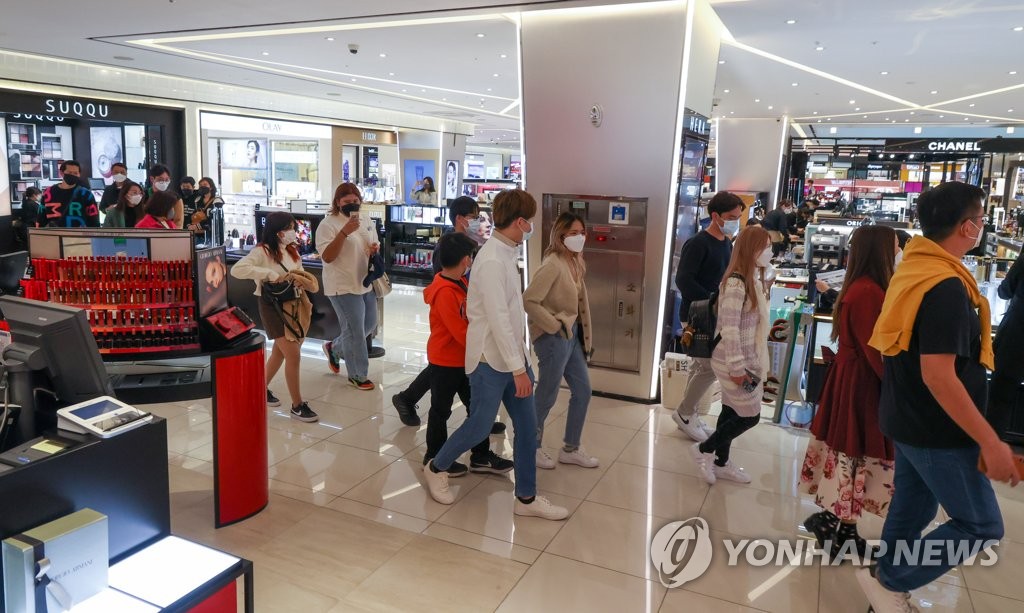SEOUL, April 17 (Yonhap) — After battling the novel coronavirus (Covid-19) for two years, South Korea is edging closer to post-pandemic life with the scheduled lifting of nearly all social distancing rules.
—
The new “post-omicron” program marks the first step change in the Covid-19 response system since South Korea reported its first case on January 20, 2020.
—
From Monday, restaurants, cafes and many other commercial establishments will be able to operate freely without a curfew and people will be allowed to gather in groups regardless of the number of people.
—
The obligation to wear a mask is the only rule that will remain in place for now.
—
The mandatory seven-day quarantine for Covid-19 patients will be fully lifted at the end of May and home treatment will no longer be necessary.
—
People will also be able to be diagnosed and treated for the virus at local clinics and hospitals, similar to treatment for the flu.
—
The easing also comes with the removal of the 299-person cap for large-scale events and gatherings, as well as the 70% capacity cap for places of worship. Eating inside cinemas, gymnasiums and religious facilities will be allowed from April 25.
—
The lifting of social distancing rules demonstrates Seoul’s efforts to restore daily life to people long beset by the pandemic and help businesses, especially small business owners and the self-employed, recover from economic and financial difficulties.
—
“We will be able to get back on the path to a gradual return to normalcy,” Prime Minister Kim Boo-kyum said Friday during a government response meeting.
—
“Prevention efforts are always important (…) even if the government pushes for a return to normal, we will prepare thoroughly assuming that the risk can return,” Kim explained.
—
Health officials have signaled a total change in the pattern of response to the virus, concluding that the epidemic wave has passed its peak and is on track for a steady decline in the coming weeks.
—
Daily Covid-19 cases have plummeted after hitting a record high of more than 620,000 on March 17 at the height of Omicron’s spread, according to the Korea Disease Control and Prevention Agency (KDCA).
—
More than 30% of the country’s 52 million people have had Covid-19.
—
The new scheme precedes a planned lowering of the Covid-19 infectious disease level by one notch to Class 2 from Class 1, the highest in the four-tier system. A provisional “transition period” of four weeks will be applied before the actual implementation to allow the new system to integrate.
—
Covid-19 is currently classified alongside diseases such as Ebola virus and Middle East respiratory syndrome (Mers-CoV).
—
The downgrading of the classification level is mainly to allow patients to receive treatment in local clinics and hospitals, such as an endemic disease, so that the medical system can be normalized for general operations and focus on severe Covid cases. -19.
—
The prolonged overload due to COVID-19 has wreaked havoc on the entire medical system in the country, prompting the government to improve the situation.
—
Once the transition period is over, all medical systems will resume normal operations, as the downgrade means that authorities no longer have to force patients to quarantine or be admitted to a general hospital, nor to follow in the patient’s state of health at all times.
—
When traveling internationally, all incoming vaccinated persons will be exempt from the seven-day quarantine and will only need to submit negative polymerase chain reaction (PCR) test results upon arrival and 48 hours prior to departure .
—
The government also plans to gradually expand visa-free entry for countries that do not have the Mutual Visa Waiver Program with South Korea.
—
It also plans to revive the use of international flights by 50% this year by lifting the limit on the number of arrivals per hour at Incheon International Airport, west of Seoul, and resuming international flights in regional airports.
—
South Korea first introduced social distancing measures in March 2020, about two months after the initial outbreak.
—
The measures began with the recommendation to suspend operations in places of worship and select businesses, as the country has seen a series of cluster infections within churches and among large religious gatherings in regional provinces.
—
Social distancing rules have tightened as the spread of the virus has grown, with the government imposing a limit of five people on private gatherings across the country in January 2021 to curb the spike in infections.
—
At one point, restrictions were tightened to allow only two people to meet in the evening and only allow take-out from cafes.
—
As part of a “gradual return to normal” program, Seoul had eased distancing rules last November but later rolled them back as the country grappled with the rapid spread of the highly transmissible Omicron variant.
—
Despite the rapid easing, health officials stressed that the lifting of social distancing rules should not be seen as the “end of the coronavirus”, but as a full-fledged attempt to return to normal daily life.
—
“This system transition is not a simple adjustment of the level of infectious diseases or a relaxation of quarantine measures, but a new beginning and a very difficult challenge to safely resume daily life and establish a routine treatment system. with Covid-19,” said KDCA Director Jeong Eunkyeong.
—


